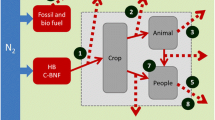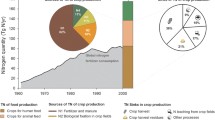Abstract
Nutrients such as nitrogen are required to secure food production. However, nitrogen cycles have been disturbed by excess nitrogen intake and low nitrogen use efficiency (NUE), which have several environmental impacts. In order to address nitrogen-related issues, the magnitude of the problem and hotspots in the value chain must first be identified. Various methods to quantify nitrogen use, NUE, and nitrogen-related environmental impact potential have been proposed to tackle this challenge. The approaches, methods, and indicators that can be used in assessing particular food systems are presented in this chapter. The methods serve different purposes and present certain differences in terms of scoping and system boundaries. The aim of this chapter is to present currently relevant methods to analyze the nitrogen footprint of a food chain in order to help those tasked with carrying out assessments to choose the method which best meets their needs.
Access this chapter
Tax calculation will be finalised at checkout
Purchases are for personal use only
Similar content being viewed by others
References
Antikainen R (2007) Substance flow analysis in Finland—four case studies on N and P flows. Monographs of the Boreal Environment Research. Finnish Environment Institute, Finland. https://helda.helsinki.fi/bitstream/handle/10138/39343/BERMon_27.pdf?sequence=1&isAllowed=y
Biodiversity Indicators Partnership (2016) Trends in loss of reactive nitrogen to the environment. https://www.bipindicators.net/indicators/trends-in-loss-of-reactive-nitrogen-to-the-environment. Accessed 3 Dec 2020
Bleeker A, Sutton M, Winiwarter W et al (2013) Economy-wide nitrogen balances and indicators: Concept and methodology. https://one.oecd.org/document/ENV/EPOC/WPEI(2012)4/REV1/en/pdf. Accessed 8 December 2020
Chatzimpiros P, Barles S (2013) Nitrogen food-print: N use related to meat and dairy consumption in France. Biogeosciences 10:471–481. https://doi.org/10.5194/bg-10-471-2013
Einarsson R, Cederberg C (2019) Is the nitrogen footprint fit for purpose? An assessment of models and proposed uses. J Environ Manag 240:198–208. https://doi.org/10.1016/j.jenvman.2019.03.083
Erisman JW, Leach A, Bleeker A, Atwell B, Cattaneo L, Galloway J (2018) An integrated approach to a nitrogen use efficiency (NUE) indicator for the food production-consumption chain. Sustainability 10:925. https://doi.org/10.3390/su10040925
Fang K, Heijungs R (2015) Rethinking the relationship between footprints and LCA. Environ Sci Technol 49:10–11. https://doi.org/10.1021/es5057775
Galloway JN, Townsend AR, Erisman JW et al (2008) Transformation of the nitrogen cycle: recent trends, questions, and potential solutions. Science 320:889–892. https://doi.org/10.1126/science.1136674
Galloway JN, Winiwarter W, Leip A et al (2014) Nitrogen footprints: past, present and future. Environ Res Lett 9:115003. https://doi.org/10.1088/1748-9326/9/11/115003
Grönman K, Ypyä J, Virtanen Y et al (2016) Nutrient footprint as a tool to evaluate the nutrient balance of a food. J Clean Prod 112:2429–2440. https://doi.org/10.1016/j.jclepro.2015.09.129
Hayashi K, Oita A, Nishina K (2020) Concealed nitrogen footprint in protein-free foods: an empirical example using oil palm products. Environ Res Lett 15: https://doi.org/10.1088/1748-9326/ab68ea
ISO 14040 (2006) Environmental management. Life cycle assessment. Principles and framework
Joensuu K, Pulkkinen H, Kurppa S et al (2019) Applying the nutrient footprint method to the beef production and consumption chain. Int J Life Cycle Assess 24:26–36. https://doi.org/10.1007/s11367-018-1511-3
Leach AM, Emery KA, Gephart J et al (2016) Environmental impact food labels combining carbon, nitrogen, and water footprints. Food Policy 61:213–223. https://doi.org/10.1016/j.foodpol.2016.03.006
Leach AM, Galloway JN, Bleeker A et al (2012) A nitrogen footprint model to help consumers understand their role in nitrogen losses to the environment. Environ Dev 1(1):40–66. https://doi.org/10.1016/j.envdev.2011.12.005
Leach AM, Majidi AN, Galloway JN et al (2013) Toward institutional sustainability: A nitrogen footprint model for a university. Sustainability 6(4):211–219. https://doi.org/10.1089/sus.2013.9852
Li M, Wiedmann T, Hadjikakou M (2019) Towards meaningful consumption-based planetary boundary indicators: The phosphorus exceedance footprint. Glob Environ Change 54:227–238. https://doi.org/10.1016/j.gloenvcha.2018.12.005
Ridoutt BG, Pfister S, Manzardo A et al (2016) Area of concern: a new paradigm in life cycle assessment for the development of footprint metrics. Int J Life Cycle Assess 21:276–280. https://doi.org/10.1007/s11367-015-1011-7
Rockström J, Steffen W, Noone K et al (2019) A safe operating space for humanity. Nature 461:472–475. https://doi.org/10.1038/461472a
Service, RF (2019) New reactor could halve carbon dioxide emissions from ammonia production. Science. 6 November. Available at: https://www.sciencemag.org/news/2019/11/new-reactor-could-halve-carbon-dioxide-emissions-ammonia-production. Cited at 23 September 2020
Steffen W, Richardson K, Rockström J et al (2015) Planetary boundaries: Guiding human development on a changing planet. Science 347(6223):1259855. https://doi.org/10.1126/science.1259855
Sutton, MA, Bleeker A, Howard CM et al (2013). Our nutrient world: the challenge to produce more food and energy with less pollution. Global overview on nutrient management. Centre for Ecology and Hydrology, Edinburgh on behalf of the Global Partnership on Nutrient Management and the International Nitrogen Initiative. Available at: https://library.wur.nl/WebQuery/wurpubs/reports/434951. Cited at 20 November 2020
Uusitalo V, Kuokkanen A, Grönman K et al (2019) Environmental sustainability assessment from planetary boundaries perspective—A case study of an organic sheep farm in Finland. Sci Total Environ 687:168–176. https://doi.org/10.1016/j.scitotenv.2019.06.120
Uwizeye A, Gerber PJ, Schulte RPO, de Boer IJM (2016) A comprehensive framework to assess the sustainability of nutrient use in global livestock supply chains. J Clean Prod 129:647–658. https://doi.org/10.1016/j.jclepro.2016.03.108
Leip A, Leach A, Musinguzi P, et al (2014) Nitrogen-neutrality: a step towards sustainability. Environ. Res. Lett. 9:115001. https://doi.org/10.1088/1748%2D9326%2F9%2F11%2F115001
Author information
Authors and Affiliations
Corresponding author
Editor information
Editors and Affiliations
Rights and permissions
Copyright information
© 2022 The Author(s), under exclusive license to Springer Nature Switzerland AG
About this chapter
Cite this chapter
Grönman, K., Lakanen, L., Kasurinen, H. (2022). Nitrogen Footprint of a Food Chain. In: Ren, J. (eds) Advances of Footprint Family for Sustainable Energy and Industrial Systems. Green Energy and Technology. Springer, Cham. https://doi.org/10.1007/978-3-030-76441-8_8
Download citation
DOI: https://doi.org/10.1007/978-3-030-76441-8_8
Published:
Publisher Name: Springer, Cham
Print ISBN: 978-3-030-76440-1
Online ISBN: 978-3-030-76441-8
eBook Packages: EnergyEnergy (R0)




